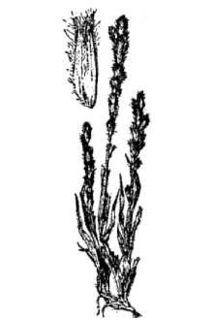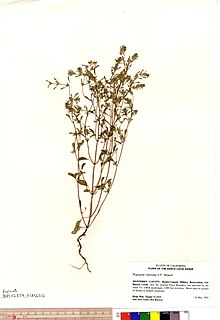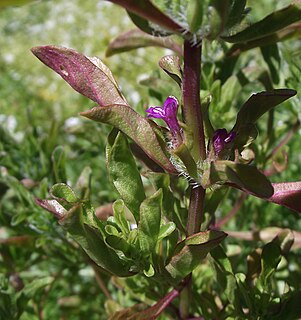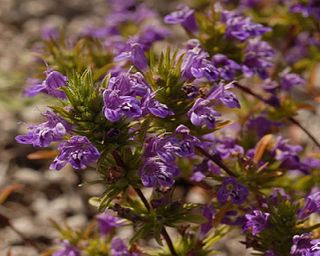
Pogogyne is a small genus of flowering plants in the mint family known generally as mesamints or mesa mints. They are native to Oregon, Idaho, California, and Baja California.

Lasthenia burkei is a rare species of flowering plant in the family Asteraceae known by the common names Burke's goldfields and Burke's baeria.

Eryngium aristulatum, known by the common names California eryngo and Jepson's button celery, is a species of flowering plant in the family Apiaceae.

Dudleya brevifolia, is a rare succulent plant known by the common name short-leaved liveforever, short-leaved dudleya or rarely the Del Mar Hasseanthus. It is an edaphic endemic that only grows on the mesas of the most ancient marine terraces, hiding in the vicinity of ironstone concretions. The leaves are deciduous, and disappear after the inflorescence develops. When flowering, it has a conspicuous white flower, which is in the shape of a star with a yellow center. After flowering, any above-ground trace of the plant will disappear, and it survives under the earth with a starch-rich subterranean caudex. It is only found on a strip of coast in San Diego County, California.

Acanthomintha ilicifolia, known by the common name San Diego thornmint, is a rare species of flowering plant in the mint family. It is native to Baja California and San Diego County, California, where it is a resident of the chaparral and coastal sage scrub plant communities and vernal pools.

Ambrosia pumila is a rare species of herbaceous perennial plant known by the common names San Diego ragweed and San Diego ambrosia. It is native to far southern California, Baja California, and Baja California Sur. It grows in floodplains and open grasslands in proximity to wetland areas.
Blennosperma bakeri is a rare species of flowering plant in the daisy family known by the common names Baker's stickyseed and Sonoma sunshine.

Brodiaea filifolia, known by the common name threadleaf brodiaea, is a rare species of flowering plant in the cluster-lily genus. It is endemic to southern California, mostly in the region around the junction of Orange, Riverside, and San Diego Counties.

Chloropyron molle is a species of flowering plant in the family Orobanchaceae.

Navarretia fossalis is a rare species of flowering plant in the phlox family known by the common name spreading navarretia.

Navarretia leucocephala is a species of flowering plant in the phlox family known by the common name whitehead pincushionplant, or whitehead navarretia. It is native to North America, including much of the western United States and central Canada. It generally grows in wet or moist terrestrial habitat such as vernal pools.

Orcuttia californica is a rare species of grass known by the common name California Orcutt grass.
Orcuttia inaequalis is a rare species of grass known by the common name San Joaquin Valley Orcutt grass.

Orcuttia pilosa is a rare species of grass known by the common name hairy Orcutt grass.

Phacelia stellaris is a rare species of flowering plant in the borage family, Boraginaceae, known by the common names star phacelia and Brand's phacelia.

Pogogyne clareana is a rare species of flowering plant in the mint family known by the common name Santa Lucia mint. It is endemic to Monterey, California, where it is known only from about fifty occurrences all located within the bounds of Fort Hunter Liggett, a US Army training facility. The local habitat is made up of chaparral and oak woodland with occasional vernal pools and summer-dry creek beds.

Pogogyne douglasii is a species of flowering plant in the mint family known by the common names Douglas' mesamint and Douglas' beardstyle.

Pogogyne nudiuscula is a rare species of flowering plant in the mint family known by the common name Otay mesa mint. It is native to southern San Diego County, California, where it is known only from Otay Mesa near the border with Baja California. It was identified on land south of the Mexican border, but these occurrences have probably been extirpated. It is now known from seven vernal pool complexes just north of the border, and it is a federally listed endangered species of the United States.
Pogogyne zizyphoroides is a species of flowering plant in the mint family known by the common names Sacramento mesamint and Sacramento beardstyle.
Monardella stoneana is a rare species of flowering plant in the mint family known by the common name Jennifer's monardella.
















